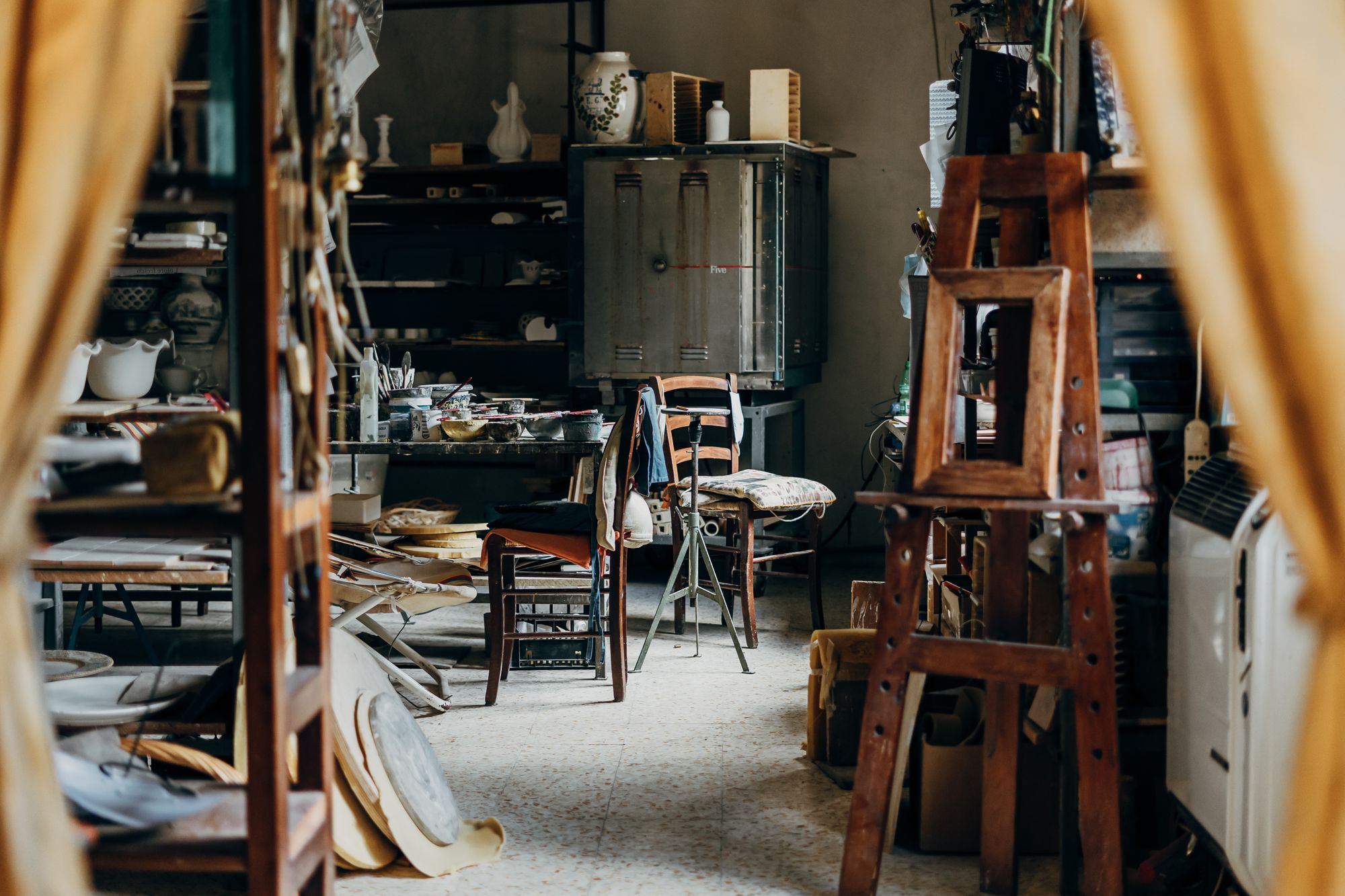The global furniture market is projected to grow at a compound annual growth rate (CAGR) of 5.1% from 2021 to 2028, reaching a value of $1,150.8 billion by 2028. (Source: Grand View Research)
According to the Sustainable Furnishings Council's 2021 Green Home Furnishings Consumer Study, 74% of consumers said that sustainability is somewhat or very important when purchasing furniture. (Source: Sustainable Furnishings Council)
In 2021, the demand for eco-friendly furniture products has increased significantly, with consumers seeking sustainable materials and production processes. (Source: Furniture Today)

Furniture manufacturing and recycling are two related industries that play a significant role in the global economy and environment. The furniture manufacturing industry involves the production of furniture, including chairs, tables, cabinets, and other furnishings, using various materials such as wood, metal, and plastics. Furniture recycling involves the disassembly, sorting, and processing of used furniture to extract useful materials such as metal, wood, and fabric for reuse or recycling.
Both furniture manufacturing and recycling are crucial for meeting the needs of consumers while reducing the impact of these industries on the environment. Furniture manufacturers strive to create high-quality products that are durable, functional, and aesthetically pleasing while ensuring the responsible use of natural resources. At the same time, furniture recyclers seek to divert used furniture from landfills, conserve natural resources, and reduce the environmental impact of furniture production.
With the increasing demand for sustainable products and practices, both furniture manufacturing and recycling industries are undergoing significant changes.
This article will be your complete guide for furniture manufacturing and recycling by covering the following topics:
- Furniture and its Widespread Use
- History and Process of Furniture Manufacturing
- What is Furniture Manufacturing?
- What is Furniture Recycling?
- Importance of Furniture Manufacturing
- Importance of Furniture Recycling
- Types of Furniture Commonly Used and Their Properties
- Environmental Impact of Furniture Waste
- Benefits of Furniture Recycling
- Different Types of Furniture Recycling Processes
- Challenges of Furniture Recycling
- Innovations in Sustainable Furniture Manufacturing and Recycling
- Circular Economy Models for Furniture Waste Management
- Regulations and Policies related to Furniture Manufacturing and Recycling
- Industry Initiatives and Collaborations to Reduce Furniture Waste
- Future of Furniture Manufacturing and Recycling
- Opportunities and Challenges in the Furniture Manufacturing Industry
- Potential Solutions and Innovations to Create a More Sustainable Future for Furniture
- How can Consumers Promote Sustainability in Furniture Manufacturing and Recycling?
- How can ERP and MRP Systems help Furniture Manufacturers?
- How can Deskera Help You with Furniture Manufacturing and Recycling?
- Key Takeaways
- Related Articles
Furniture and its Widespread Use
Furniture refers to movable objects that are used to support various human activities, such as seating (chairs, sofas, stools), sleeping (beds), storage (cabinets, drawers), and dining (tables). Furniture has been a part of human civilization for thousands of years, with evidence of furniture dating back to ancient Egypt and Greece.
The widespread use of furniture can be attributed to several factors, including increased wealth and urbanization, technological advancements in furniture production, and changes in societal norms and lifestyles. As people have become more affluent and urbanized, they have had greater access to a wider variety of furniture options, from basic pieces to more luxurious and ornate items.
Technological advancements in furniture production have also played a significant role in the widespread use of furniture. With the advent of industrialization, furniture could be produced more quickly and inexpensively, making it more accessible to a wider range of people. Additionally, innovations in materials and manufacturing techniques have allowed furniture to become more comfortable, durable, and aesthetically pleasing.
Changes in societal norms and lifestyles have also contributed to the widespread use of furniture. As people have increasingly focused on comfort and convenience in their daily lives, furniture has become an essential aspect of modern living. Additionally, the rise of remote work and virtual communication has led to an increased demand for home office furniture, while the popularity of home entertainment has created a need for comfortable and functional living room furniture.
Overall, furniture has become an integral part of modern life, serving not only practical purposes but also aesthetic and emotional ones. It is a reflection of our cultural and societal values, as well as our personal preferences and tastes.
History and Process of Furniture Manufacturing
Furniture manufacturing has a long and rich history, dating back thousands of years to ancient civilizations such as Egypt and Greece. The earliest furniture was often made from natural materials such as wood, stone, and animal hides and was primarily functional in nature.
As technology advanced, so did the process of furniture manufacturing. The Industrial Revolution, which began in the late 18th century, brought about a significant change in the way the furniture was produced. Mass production techniques were developed, allowing furniture to be made more quickly and inexpensively than ever before.
Today, furniture manufacturing typically involves several stages, including design, materials selection, cutting, shaping, joining, finishing, and assembly. Let's take a closer look at each of these stages:
- Design: Furniture design can be done by hand, using sketches and drawings, or using computer-aided design (CAD) software. The design stage is crucial in determining the size, shape, and style of the piece of furniture.
- Materials Selection: Once the design is complete, the next step is to select the materials that will be used to make the furniture. This may include wood, metal, plastic, glass, or fabric.
- Cutting: Once the materials have been selected, they are cut to the appropriate size and shape using saws, drills, and other cutting tools.
- Shaping: After the materials have been cut, they are shaped using a variety of tools, such as routers, sanders, and lathes. This stage may involve carving, turning, or bending the materials to achieve the desired shape.
- Joining: The different pieces of furniture are then joined together using a variety of techniques, such as gluing, nailing, screwing, or stapling.
- Finishing: Once the furniture has been assembled, it is sanded and finished with paint, varnish, or other coatings to protect the surface and give it the desired appearance.
- Assembly: Finally, the furniture is assembled, and any additional components, such as hardware, are added.
Throughout the furniture manufacturing process, quality control measures are taken to ensure that each piece meets the required standards of durability, safety, and aesthetics.
Furniture manufacturing is a complex process that requires a combination of craftsmanship and technology, and it continues to evolve as new materials and techniques are developed.
What is Furniture Manufacturing?
Furniture manufacturing refers to the process of producing furniture, which involves creating functional and decorative objects that are designed to support various human activities such as seating, sleeping, storage, and dining. The manufacturing process includes a range of activities such as designing, selecting materials, cutting, shaping, joining, finishing, and assembly.
The furniture manufacturing process typically begins with the design stage, where the overall shape and style of the piece of furniture are determined. This can be done through computer-aided design (CAD) software or by hand using sketches and drawings. Once the design is complete, the materials are selected based on factors such as durability, aesthetics, and cost.
Next, the materials are cut to the appropriate size and shape using various cutting tools such as saws, drills, and routers. Then, the materials are shaped using a variety of tools such as sanders, lathes, and routers to achieve the desired form.
After the materials have been cut and shaped, they are joined together using a range of techniques such as gluing, nailing, screwing, or stapling. Once the furniture has been assembled, it is sanded and finished with paint, varnish, or other coatings to protect the surface and enhance its appearance.
Throughout the furniture manufacturing process, quality control measures are taken to ensure that the final product meets the required standards of durability, safety, and aesthetics. Furniture manufacturing requires a combination of craftsmanship and technology, and it continues to evolve as new materials and techniques are developed.
What is Furniture Recycling?
Furniture recycling is the process of reusing or refurbishing furniture that would otherwise end up in a landfill. This process involves taking old, worn, or unwanted furniture and giving it a new lease of life, either by repairing it or repurposing it for a different use.
Furniture recycling can take many forms, including:
- Refurbishing: This involves repairing or restoring old or worn furniture to its original condition. This may involve fixing broken parts, reupholstering, or refinishing the furniture to give it a new look.
- Repurposing: This involves taking old furniture and using it for a different purpose. For example, an old bookshelf could be repurposed as a TV stand or an old dresser could be used as a bathroom vanity.
- Upcycling: This involves taking old or discarded furniture and using it to create something new and unique. For example, an old door could be turned into a coffee table, or an old ladder could be repurposed as a bookshelf.
Furniture recycling has several benefits, including:
- Environmental benefits: By recycling furniture, we can reduce the amount of waste that ends up in landfills, which can help to reduce greenhouse gas emissions and preserve natural resources.
- Economic benefits: Recycling furniture can help to create jobs and stimulate local economies by providing opportunities for small businesses and artisans.
- Social benefits: Recycling furniture can help to provide affordable and high-quality furniture to people who might not otherwise be able to afford it, such as low-income families or students.
Overall, furniture recycling is an important way to reduce waste, support local economies, and create unique and affordable furniture solutions.
Importance of Furniture Manufacturing
Furniture manufacturing is an essential industry that plays a crucial role in the global economy and society. Here are some key reasons why furniture manufacturing is important:
- Meeting basic needs: Furniture is an essential aspect of everyday life, providing people with a comfortable place to sit, sleep, eat, and work.
- Employment and economic growth: Furniture manufacturing provides employment opportunities for millions of people worldwide and contributes significantly to the global economy.
- Design and innovation: Furniture manufacturing involves creative design and innovation, which can drive progress and improve people's quality of life.
- Customization: Furniture manufacturing allows for the customization of products to meet individual customer needs and preferences.
- Sustainability: Furniture manufacturing can contribute to sustainability by using renewable materials, implementing circular economy principles, and reducing waste.
- Cultural heritage: Furniture manufacturing can preserve and promote cultural heritage through the production of traditional furniture designs and craftsmanship.
Overall, furniture manufacturing is an essential industry that contributes to society in many ways, providing people with comfortable, functional, and aesthetically pleasing furniture while supporting employment and economic growth.
Importance of Furniture Recycling
Furniture manufacturing and recycling are important for several reasons, including:
- Resource conservation: Furniture recycling and sustainable manufacturing practices help conserve natural resources, reducing the need for new raw materials and minimizing waste.
- Waste reduction: Furniture recycling helps reduce waste by diverting used furniture products from landfills and promoting circular economy initiatives.
- Energy conservation: Sustainable furniture manufacturing practices can help conserve energy by reducing the amount of energy required for production and transportation.
- Environmental protection: Sustainable furniture practices help protect the environment by reducing greenhouse gas emissions, minimizing air and water pollution, and preserving natural habitats.
- Economic benefits: Furniture recycling and sustainable manufacturing practices can create economic benefits by promoting the growth of green industries, creating new jobs, and reducing the costs associated with waste management.
- Social responsibility: Sustainable furniture practices promote social responsibility by reducing the environmental impact of furniture production and promoting ethical and sustainable practices throughout the supply chain.
Overall, furniture manufacturing and recycling are important for promoting sustainability, conserving natural resources, reducing waste, and protecting the environment and the economy.
Types of Furniture Commonly Used and Their Properties
There are many different types of furniture commonly used in homes, offices, and other settings, each with its own unique properties and characteristics. Here are some of the most common types of furniture and their properties:
- Wood furniture: Wood is a versatile and durable material that is often used in furniture manufacturing. It can range from light and natural to dark and polished and can be finished with various stains and varnishes. Wood furniture can be both traditional and modern in design and is often used in high-quality, long-lasting pieces.
- Metal furniture: Metal furniture is often used in contemporary or industrial-style designs. It is strong and durable and can be finished in a variety of colors and textures. Metal furniture is often lightweight and easy to move, making it a good choice for spaces that need to be flexible.
- Upholstered furniture: Upholstered furniture, such as sofas, chairs, and ottomans, is covered in fabric or leather and filled with foam or other cushioning materials. It is often used for seating and can be both comfortable and stylish. Upholstered furniture is available in a wide range of colors and patterns, making it easy to match with other decors.
- Plastic furniture: Plastic furniture is lightweight, easy to clean, and often used in outdoor settings. It can be made in a range of bright colors and fun shapes and is often used in casual or informal settings.
- Glass furniture: Glass furniture, such as tables and shelving, can add a modern and elegant touch to any space. It is durable and easy to clean and can be tempered for added safety. Glass furniture can also be made in a range of colors and patterns to match other decors.
- Wicker furniture: Wicker furniture is made from natural woven fibers such as rattan, bamboo, or willow. It is lightweight and durable, making it a good choice for outdoor settings. Wicker furniture can add a rustic or natural feel to a space and is often used in the casual or bohemian-style decor.
Overall, the type of furniture chosen will depend on the desired style, function, and setting of the space. By understanding the properties and characteristics of each type of furniture, it is easier to make an informed decision when selecting furniture for a particular space.
Environmental Impact of Furniture Waste
The environmental impact of furniture waste can be significant. When furniture is disposed of in landfills, it takes up space and can release harmful chemicals into the environment. The decomposition of furniture can also release methane, a potent greenhouse gas that contributes to climate change.
In addition, furniture production often involves the use of natural resources such as wood, water, and energy and can contribute to deforestation and other environmental problems. Furniture manufacturing also often involves the use of chemicals and other materials that can be harmful to the environment and human health.
To minimize the environmental impact of furniture waste, it is important to reduce, reuse, and recycle furniture whenever possible. This can be done by repairing or refurbishing furniture instead of throwing it away, donating or selling used furniture to others who may be able to use it, and recycling materials such as wood, metal, and plastic.
In addition, choosing sustainable and environmentally friendly furniture can also help to reduce the environmental impact of furniture production and waste. This can include choosing furniture made from recycled or renewable materials, such as bamboo or recycled plastic, and opting for furniture that is designed to last a long time and can be repaired or recycled at the end of its life.
Overall, by taking steps to reduce, reuse, and recycle furniture and by choosing sustainable and environmentally friendly furniture whenever possible, we can help to minimize the environmental impact of furniture waste and promote a more sustainable future.
Benefits of Furniture Recycling
Furniture recycling can have several benefits, including:
- Environmental benefits: Recycling furniture can help reduce the amount of waste that goes to landfills, which can help conserve landfill space and reduce greenhouse gas emissions. By recycling furniture, we can also reduce the need for virgin materials such as wood, metal, and plastic, which can help conserve natural resources and reduce energy consumption.
- Economic benefits: Recycling furniture can create jobs in the recycling industry and can help support local economies. It can also be a cost-effective way to furnish a home or office, as recycled furniture is often less expensive than new furniture.
- Social benefits: Donating or selling used furniture can help support charitable organizations and provide affordable furniture to people who may not be able to afford new furniture. This can help promote social equity and improve the quality of life for individuals and families.
- Design benefits: Recycling furniture can also promote creative design solutions, as repurposing or refurbishing old furniture can create unique and personalized pieces that are tailored to specific needs and preferences.
- Job creation: Recycling furniture can create jobs in the recycling industry and can help support local economies. This can help promote economic growth and improve the quality of life for individuals and families.
- Charitable giving: Donating or selling used furniture can help support charitable organizations and provide affordable furniture to people who may not be able to afford new furniture. This can help promote social equity and improve the quality of life for individuals and families.
- Customization: Recycling furniture can promote creative design solutions, as repurposing or refurbishing old furniture can create unique and personalized pieces that are tailored to specific needs and preferences. This can help create a more personalized and unique living space.
- Reducing waste: By recycling furniture, we can reduce the amount of waste that goes to landfills and reduce the environmental impact of furniture production. This can help promote a more sustainable and environmentally friendly future.
Overall, furniture recycling can have many benefits for the environment, economy, and society and can help promote a more sustainable and equitable future.
Different Types of Furniture Recycling Processes
There are different types of furniture recycling processes, each with its own advantages and limitations. Some of the most common furniture recycling processes include:
- Refurbishing: Refurbishing involves repairing, restoring, and refinishing old or damaged furniture. This process can include stripping, sanding, painting, staining, and reupholstering to bring the furniture back to its original condition or to update its look. Refurbishing is a popular way to extend the life of furniture and make it functional and attractive again.
- Repurposing: Repurposing is a creative way to recycle furniture. This process involves taking old furniture and using it for a different purpose than its original intended use. For example, a dresser can be converted into a bathroom vanity, a table can be turned into a workbench, or a bed frame can be used to make a garden trellis. Repurposing can add unique and personalized touches to a living space while keeping old furniture out of landfills.
- Upcycling: Upcycling is another creative way to recycle furniture. This process involves taking old or unwanted furniture and transforming it into something new and different. Upcycling can involve using parts of old furniture to create something entirely new, such as turning an old door into a headboard or using old chair legs to make a coffee table. Upcycling is a great way to give new life to the old furniture and reduce waste.
- Donating: Donating unwanted furniture is an excellent way to recycle it. Many charities and non-profit organizations accept furniture donations and redistribute them to people in need. Donating furniture can help support a worthy cause and provide affordable furniture to those who may not be able to afford new furniture.
- Selling: Selling old or unwanted furniture can be a way to recycle it while earning some money. There are many online marketplaces, such as Craigslist or Facebook Marketplace, where people can sell used furniture. This is a great way to make some extra cash while keeping furniture out of landfills.
- Recycling: Recycling furniture involves breaking it down into its component materials and using them to make new products. This process involves shredding or grinding the furniture into smaller pieces and then using the resulting materials to create new products. Recycling is a great way to reduce waste and conserve natural resources.
- Composting: Composting is a way to recycle natural materials used in furniture. For example, sawdust, wood chips, and other organic materials used in furniture manufacturing can be composted to create nutrient-rich soil. Composting is a great way to reduce waste and create sustainable gardening practices.
Overall, there are many different types of furniture recycling processes available. Choosing the right process depends on the condition of the furniture, its intended use, and the available resources and facilities for recycling.
Challenges of Furniture Recycling
Furniture recycling is the process of converting used or unwanted furniture into new products or materials. While it has numerous benefits, including reducing waste and saving resources, there are several challenges associated with furniture recycling. Some of these challenges include:
- Lack of Infrastructure: One of the biggest challenges of furniture recycling is the lack of infrastructure. There are not enough facilities available to process and recycle furniture, which can make it difficult for people to dispose of their old furniture responsibly.
- Transportation: Furniture is often bulky and heavy, which can make transportation a challenge. Moving furniture from one location to another requires special equipment and can be expensive, especially for individuals or small businesses.
- Quality of Recycled Materials: The quality of recycled materials is an important consideration in furniture recycling. Often, recycled materials may not be of the same quality as new materials, which can limit their usefulness in certain applications.
- Limited Market: There is a limited market for recycled furniture and products made from recycled furniture. This can make it difficult for furniture recycling companies to operate profitably and can limit the demand for recycled furniture.
- Contamination: Furniture can be contaminated with various substances, such as chemicals or mold, which can make it difficult to recycle. Contaminated furniture may require special handling and disposal procedures, which can increase the cost of recycling.
- Design Constraints: Design constraints can also be a challenge in furniture recycling. Certain types of furniture may be difficult to disassemble and recycle due to their complex design, which can limit their recyclability.
Overall, these challenges highlight the importance of developing a comprehensive and efficient infrastructure for furniture recycling.
Innovations in Sustainable Furniture Manufacturing and Recycling
In recent years, there have been several innovations in sustainable furniture manufacturing and recycling that aim to reduce waste and environmental impact. Some of these innovations include:
- Sustainable Materials: Sustainable furniture manufacturing involves using materials that are renewable, recycled, or biodegradable. Some examples include bamboo, cork, recycled plastic, and reclaimed wood.
- 3D Printing: 3D printing technology has been used to create furniture pieces from recycled materials such as plastics, metals, and glass. The use of 3D printing enables designers to create complex and customized furniture designs while reducing material waste.
- Circular Design: The concept of circular design involves designing products to be reused, repurposed, or recycled at the end of their life cycle. Furniture manufacturers are adopting this concept by designing furniture that can be easily disassembled and recycled.
- Lean Manufacturing: Lean manufacturing is a production system that aims to minimize waste and improve efficiency. Furniture manufacturers are adopting this approach by using data and analytics to optimize production processes, reduce material waste, and increase energy efficiency.
- Upcycling: Upcycling is the process of transforming waste materials into new products of higher value. Furniture manufacturers are using upcycling to create unique and eco-friendly furniture pieces by repurposing old materials such as shipping pallets, car parts, and industrial machinery.
- Digital Tools: Digital tools such as CAD (Computer-Aided Design) and BIM (Building Information Modeling) enable furniture manufacturers to design and prototype furniture in a virtual environment, reducing material waste and cost.
These innovations are making sustainable furniture manufacturing and recycling more accessible and cost-effective. As consumers become more aware of the environmental impact of their purchases, the demand for sustainable furniture will continue to grow, encouraging manufacturers to invest in sustainable practices and technologies.
Circular Economy Models for Furniture Waste Management
A circular economy model for furniture waste management involves designing a system where furniture products and materials are kept in use for as long as possible and then reused, repaired, refurbished, or recycled.
Some of the circular economy models for furniture waste management include:
- Extended Producer Responsibility (EPR): EPR is a policy approach where manufacturers are responsible for the end-of-life management of their products. Furniture manufacturers are required to take back their products at the end of their useful life and either refurbish or recycle them.
- Product-as-a-Service (PaaS): PaaS is a business model where the manufacturer retains ownership of the product and provides it to the customer as a service. Furniture manufacturers can lease their products to customers, and when the lease term ends, the manufacturer takes back the product for refurbishing or recycling.
- Material Recovery and Recycling: This model involves the collection of used furniture products and materials, sorting them, and then recycling them into new products or materials. Materials such as wood, plastic, and metal can be recycled into new furniture products or used in other industries.
- Repair and Refurbishment: This model involves the repair and refurbishment of used furniture products, extending their lifespan and reducing the need for new products. Furniture repair and refurbishment businesses can specialize in restoring furniture pieces to their original condition or customizing them to meet the customer's needs.
- Collaborative Consumption: Collaborative consumption is a model where customers share ownership of a product. Furniture-sharing services, such as rental or subscription-based services, can allow customers to access furniture products without having to own them, reducing the need for new furniture products.
Implementing these circular economy models can significantly reduce the amount of furniture waste that ends up in landfills and help conserve natural resources.
It also presents an opportunity for furniture manufacturers to create new revenue streams by offering refurbishing or recycling services.
Regulations and Policies related to Furniture Manufacturing and Recycling
There are several regulations and policies related to furniture manufacturing and recycling that aim to reduce the environmental impact of the industry. Some of these regulations and policies include:
- Environmental Protection Agency (EPA) regulations: The EPA has regulations that address the environmental impact of furniture manufacturing and recycling, such as the Resource Conservation and Recovery Act (RCRA) and the Clean Air Act.
- Extended Producer Responsibility (EPR) laws: EPR laws make manufacturers responsible for the end-of-life management of their products, including furniture. EPR laws can require manufacturers to take back their products at the end of their useful life and recycle or dispose of them responsibly.
- Energy Efficiency Standards: Energy efficiency standards set minimum efficiency requirements for furniture products, such as lighting and office equipment. These standards can reduce energy consumption and greenhouse gas emissions associated with furniture manufacturing.
- Sustainable Procurement Policies: Some governments and organizations have sustainable procurement policies that require them to purchase furniture products that meet certain environmental and social standards, such as using sustainable materials or reducing waste.
- Voluntary Certification Programs: Voluntary certification programs, such as the Forest Stewardship Council (FSC) certification, provide a framework for ensuring that furniture products meet certain environmental and social standards.
- Recycling and Waste Reduction Programs: Many municipalities have recycling and waste reduction programs that include furniture recycling. These programs can offer collection services or drop-off locations for used furniture products.
By implementing these regulations and policies, governments and organizations can promote sustainable practices in the furniture industry and reduce its environmental impact.
Manufacturers can also benefit from these policies by reducing their costs and improving their reputation by adopting sustainable practices.
Industry Initiatives and Collaborations to Reduce Furniture Waste
There are several industry initiatives and collaborations aimed at reducing furniture waste, promoting sustainability and circularity, and improving the environmental performance of the furniture industry.
Some of these initiatives and collaborations include:
- The Furniture Industry Sustainability Program (FISP): FISP is a voluntary program in the UK that promotes sustainability in the furniture industry. FISP members commit to reducing their environmental impact by adopting sustainable practices, such as using sustainable materials, reducing waste, and promoting recycling.
- The Sustainable Furnishings Council (SFC): The SFC is a non-profit organization in the US that promotes sustainable practices in the furniture industry. The SFC provides education, certification, and networking opportunities to members, encouraging them to adopt sustainable practices, such as using sustainable materials, reducing waste, and promoting recycling.
- The Ellen MacArthur Foundation: The Ellen MacArthur Foundation is a global non-profit organization that promotes the circular economy. The foundation works with businesses, governments, and other organizations to accelerate the transition to a circular economy and reduce waste.
- The Cradle to Cradle Products Innovation Institute: The Cradle to Cradle Products Innovation Institute is a non-profit organization that provides certification for products that meet certain sustainability and circularity standards. Furniture manufacturers can earn Cradle to Cradle certification by using sustainable materials, reducing waste, and promoting recycling.
- The European Furniture Industries Confederation (EFIC): EFIC is an organization that represents the furniture industry in Europe. EFIC promotes sustainability and circularity in the industry, advocating for policies and regulations that support sustainable practices, such as extended producer responsibility and sustainable procurement.
- Collaborations between furniture manufacturers and waste management companies: Some furniture manufacturers collaborate with waste management companies to promote recycling and reduce waste. These collaborations can include take-back programs, recycling initiatives, and joint projects aimed at reducing the environmental impact of the furniture industry.
These initiatives and collaborations demonstrate the industry's commitment to sustainability and circularity and can help reduce furniture waste and improve the environmental performance of the industry.
Future of Furniture Manufacturing and Recycling
The future of furniture manufacturing and recycling is likely to be shaped by sustainability concerns, technological advancements, and changing consumer preferences.
Some potential trends and developments that could shape the future of the industry include:
- Circular Economy Business Models: The adoption of circular economies business models, such as product-as-a-service and extended producer responsibility, will likely become more common in the furniture industry. These models can help reduce waste and promote the reuse and recycling of materials.
- Sustainable Materials: The use of sustainable materials in furniture manufacturing, such as bamboo, recycled plastic, and reclaimed wood, will likely increase. Sustainable materials can help reduce the environmental impact of the industry and improve its circularity.
- 3D Printing and Digital Manufacturing: The use of 3D printing and digital manufacturing technologies could revolutionize the furniture industry. These technologies can reduce waste, improve efficiency, and enable customization and personalization of furniture products.
- Smart Furniture: Smart furniture products, such as those equipped with sensors and internet connectivity, could become more prevalent in the future. Smart furniture can help optimize energy consumption, improve comfort, and enable remote monitoring and control.
- Collaborative Consumption: Collaborative consumption models, such as furniture-sharing services, could become more popular as consumers become more concerned about sustainability and seek to reduce their environmental impact.
- Government Policies and Regulations: Government policies and regulations aimed at promoting sustainability and circularity in the furniture industry, such as extended producer responsibility and sustainable procurement policies, could become more common.
Overall, the future of furniture manufacturing and recycling is likely to be characterized by a growing emphasis on sustainability, circularity, and technological innovation. The industry will need to adapt to these changes to remain competitive and meet the evolving needs of consumers and society.
Opportunities and Challenges in the Furniture Manufacturing Industry
Opportunities:
- Sustainable and Circular Business Models: The furniture manufacturing industry has an opportunity to adopt sustainable and circular business models that promote the reuse, repair, and recycling of furniture products. These models can help reduce waste, improve resource efficiency, and create new business opportunities.
- Customization and Personalization: With the advancements in technology, furniture manufacturers can offer more customization and personalization options to customers. This can help them differentiate their products, improve customer satisfaction, and increase their profitability.
- E-commerce: E-commerce is becoming increasingly popular, and furniture manufacturers can leverage this trend by offering their products online. This can help them reach a wider audience, reduce distribution costs, and improve customer convenience.
- Smart Furniture: Smart furniture products, such as those equipped with sensors and internet connectivity, can offer new functionalities and improve customer experience. For example, smart furniture can optimize energy consumption, improve comfort, and enable remote monitoring and control.
Challenges:
- Environmental Impact: The furniture manufacturing industry has a significant environmental impact, primarily due to the use of non-renewable resources, high energy consumption, and waste generation. Manufacturers must adopt sustainable practices to reduce their impact on the environment.
- Supply Chain Management: The furniture manufacturing industry relies on complex and global supply chains that can be challenging to manage. Manufacturers must ensure that their suppliers comply with ethical and sustainability standards and manage their logistics effectively.
- Labor Practices: The furniture manufacturing industry is known for poor labor practices, such as low wages, long working hours, and poor working conditions. Manufacturers must ensure that their workers are treated fairly and ethically.
- Competition: The furniture manufacturing industry is highly competitive, with many manufacturers competing for market share. Manufacturers must differentiate their products and offer competitive pricing to remain profitable.
Overall, the furniture manufacturing industry has significant opportunities to adopt sustainable and innovative business models, but it also faces significant challenges related to environmental impact, supply chain management, labor practices, and competition. Manufacturers must address these challenges to remain competitive and meet the evolving needs of customers and society.
Potential Solutions and Innovations to Create a More Sustainable Future for Furniture
There are several potential solutions and innovations that can help create a more sustainable future for furniture:
- Using Sustainable Materials: Instead of using materials like particleboard, plywood, and MDF, which can release volatile organic compounds and contribute to deforestation, manufacturers can use sustainable materials like bamboo, reclaimed wood, and recycled plastic.
- Designing for Disassembly: Furniture designed for disassembly makes it easier to recycle, repair, and reuse parts, reducing waste and environmental impact.
- Adopting Circular Business Models: By adopting circular business models, furniture manufacturers can promote the reuse, repair, and recycling of furniture products, reducing waste and creating new business opportunities.
- Sustainable Packaging: Sustainable packaging materials and methods, such as biodegradable materials and reusable shipping containers, can reduce the environmental impact of furniture products during shipping and distribution.
- Furniture-as-a-Service: This model allows customers to pay for access to furniture products rather than buying and owning them outright. This can reduce the demand for new furniture products and promote the reuse and recycling of existing products.
- Smart Furniture: Smart furniture products can optimize energy consumption, improve comfort, and enable remote monitoring and control, reducing the environmental impact of furniture products.
- 3D Printing: 3D printing can reduce waste, improve efficiency, and enable customization and personalization of furniture products, improving customer experience and reducing the environmental impact of the industry.
- Upcycling: Furniture manufacturers can upcycle used furniture products into new products, reducing waste and promoting resource efficiency.
- Sustainable Supply Chains: By ensuring that suppliers comply with ethical and sustainability standards, furniture manufacturers can reduce their environmental impact and improve their reputation. Sustainable supply chains are also the key to increased customer loyalty and positive brand marketing.
- Certification and Labels: Certification and labeling schemes can help consumers identify sustainable furniture products and incentivize manufacturers to adopt sustainable practices.
These are just a few potential solutions and innovations that can create a more sustainable future for furniture. By adopting these practices, manufacturers can reduce their environmental impact and meet the evolving needs of customers and society.
How can Consumers Promote Sustainability in Furniture Manufacturing and Recycling?
Consumers can promote sustainability in furniture manufacturing and recycling in several ways, including:
- Support sustainable brands: Consumers can choose to buy from brands that prioritize sustainability and use environmentally friendly practices in their manufacturing and distribution.
- Choose recycled or repurposed furniture: Consumers can choose furniture products made from recycled or repurposed materials, reducing waste and promoting resource efficiency.
- Donate or sell used furniture: Consumers can donate or sell their used furniture products instead of disposing of them, promoting circular economy initiatives and reducing waste.
- Participate in furniture recycling programs: Consumers can participate in furniture recycling programs offered by local governments or organizations, promoting proper disposal and reducing landfill waste.
- Choose furniture with sustainable certifications: Consumers can look for furniture products with sustainable certifications, such as FSC (Forest Stewardship Council) or GREENGUARD, indicating that the product has been produced sustainably and with minimal impact on the environment.
- Support legislation promoting sustainability: Consumers can support legislation that promotes sustainability in the furniture industry, such as regulations on waste reduction and increased use of sustainable materials.
- Educate themselves and others: Consumers can educate themselves and others about sustainable furniture practices and promote awareness of the importance of sustainability in the furniture industry.
- Support circular economy initiatives: Consumers can support circular economy initiatives such as furniture recycling programs and donate or sell used furniture products instead of disposing of them.
- Choose durable and long-lasting products: Consumers can choose furniture products that are built to last, reducing the need for frequent replacements and minimizing waste.
- Choose sustainable materials: When buying furniture, consumers can choose products made from sustainable materials such as bamboo, reclaimed wood, recycled plastic, and natural fibers.
How can ERP and MRP Systems help Furniture Manufacturers?
Enterprise Resource Planning (ERP) and Material Requirements Planning (MRP) systems can help furniture manufacturers in several ways:
- Inventory Management: ERP and MRP systems can help furniture manufacturers manage their inventory by tracking stock levels, identifying inventory shortages, and automating inventory replenishment.
- Production Planning: ERP and MRP systems can help furniture manufacturers plan their production schedules by forecasting demand, optimizing production capacity, and minimizing production lead times.
- Resource Planning: ERP and MRP systems can help furniture manufacturers plan and allocate their resources, such as labor and raw materials, more effectively, reducing waste and improving efficiency.
- Quality Control: ERP and MRP systems can help furniture manufacturers monitor and control the quality of their products by providing real-time visibility into production processes and enabling rapid response to quality issues.
- Sales and Customer Management: ERP and MRP systems can help furniture manufacturers manage their sales and customer relationships by providing real-time visibility into customer orders, preferences, and feedback and enabling personalized customer service.
- Financial Management: ERP systems can help furniture manufacturers manage their financial operations, such as accounts payable and accounts receivable, payroll, and financial reporting.
Overall, ERP and MRP systems can help furniture manufacturers improve their operational efficiency, reduce manufacturing costs, and enhance customer satisfaction. These systems can also provide valuable insights into business performance, enabling manufacturers to make data-driven decisions and adapt to changing market conditions.
How can Deskera Help You with Furniture Manufacturing and Recycling?
Deskera is a cloud-based business management software that can help with various aspects of furniture manufacturing and recycling. Here are some ways Deskera can assist:
- Manufacturing processes management: Deskera MRP can help manage the production process of furniture by keeping track of inventory, production schedules, and quality control. This can help streamline the manufacturing process and ensure that products are delivered on time and within budget.
- Sales and customer management: Deskera CRM can help manage sales orders, customer relationships, and invoicing. This can help furniture manufacturers to stay on top of their sales pipeline and ensure that customers are satisfied with their products.
- Accounting and financial management: Deskera Books can assist in managing the financial aspects of furniture manufacturing and recycling businesses. It can help with tasks such as bookkeeping, payroll, and tax compliance.
- Recycling and waste management: Deskera MRP can assist in managing the recycling and waste management processes of furniture manufacturing. This can help to ensure that waste is disposed of properly and that materials are recycled or reused when possible.
- Sustainability reporting: Deskera MRP can help track and report on sustainability metrics such as carbon emissions and waste reduction. This can help furniture manufacturing and recycling businesses to demonstrate their commitment to sustainability and meet reporting requirements.
Key Takeaways
Furniture manufacturing is the process of producing furniture, such as chairs, tables, cabinets, sofas, and other furnishings, using a variety of materials such as wood, metal, plastics, and fabrics. Here are some key takeaways related to furniture manufacturing:
- Streamlining manufacturing processes is essential to improve productivity, reduce costs, and ensure the timely delivery of products.
- Proper inventory management is critical to ensure that the necessary raw materials are available for production.
- Quality control measures should be put in place to ensure that products meet or exceed customer expectations.
- Sales and customer management are essential to maintain a healthy sales pipeline and ensuring customer satisfaction.
- Proper accounting and financial management are necessary to manage costs and maintain financial stability.
- Sustainability and waste management practices are becoming increasingly important for furniture manufacturers as customers are looking for sustainable products.
- Reporting sustainability metrics such as carbon emissions and waste reduction can help manufacturers demonstrate their commitment to sustainability and meet reporting requirements.
Furniture recycling refers to the process of converting used or discarded furniture products into new products or materials, reducing waste and promoting resource efficiency. Here are some key takeaways related to furniture recycling:
- Furniture recycling can help reduce waste and conserve natural resources, making it an environmentally sustainable practice.
- Recycling furniture requires careful disassembly and sorting of materials to ensure they can be reused or recycled properly.
- Proper waste management practices are essential to ensure that any non-recyclable materials are disposed of properly.
- Furniture recycling can provide new business opportunities, such as refurbishing or repurposing old furniture.
- Sustainability reporting can help furniture recyclers track and report on their environmental impact, providing transparency to customers and stakeholders.
- Government policies and regulations can have a significant impact on the furniture recycling industry, and furniture recyclers should stay informed and compliant with applicable laws.
- Collaboration and partnerships with other organizations can help furniture recyclers access new markets, technologies, and funding opportunities.
The importance of furniture manufacturing is:
- Meeting basic needs
- Employment and economic growth
- Design and innovation
- Customization
- Sustainability
- Cultural heritage
The importance of furniture recycling is:
- Resource conservation
- Waste reduction
- Energy conservation
- Environmental protection
- Economic benefits
- Social responsibility
The benefits of furniture recycling are:
- Environmental benefits
- Economic benefits
- Social benefits
- Design benefits
- Job creation
- Charitable giving
- Customization
- Reducing waste
The different types of furniture recycling processes are:
- Refurbishing
- Repurposing
- Upcycling
- Donating
- Selling
- Recycling
- Composting
The challenges of furniture recycling are:
- Lack of Infrastructure
- Transportation
- Quality of Recycled Materials
- Limited Market
- Contamination
- Design Constraints
Innovations in sustainable furniture manufacturing and recycling are:
- Sustainable Materials
- 3D Printing
- Circular Design
- Lean Manufacturing
- Upcycling
- Digital Tools
The regulations and policies related to furniture manufacturing and recycling are:
- Environmental Protection Agency (EPA) regulations
- Extended Producer Responsibility (EPR) laws
- Energy Efficiency Standards
- Sustainable Procurement Policies
- Voluntary Certification Programs
- Recycling and Waste Reduction Programs
Overall, Deskera can be a valuable tool for furniture manufacturers and recyclers looking to streamline their processes and improve their sustainability practices.
Related Articles












